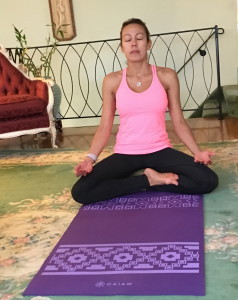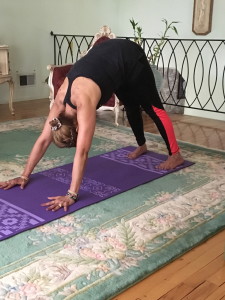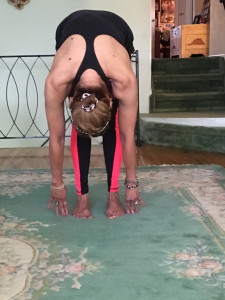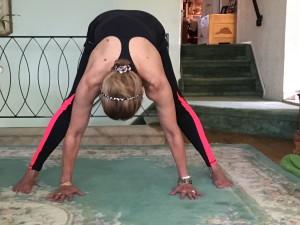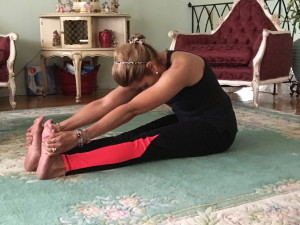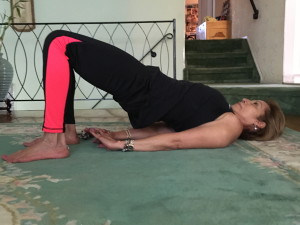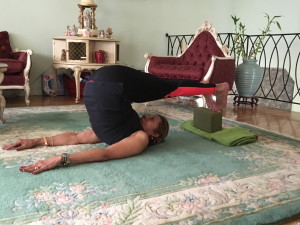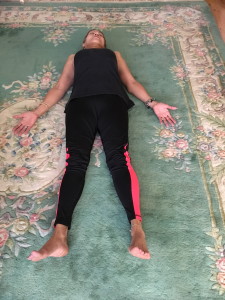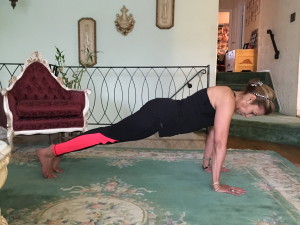Yoga, when practiced mindfully, can reduce high blood pressure by regulating the autonomic nervous system. It is the mind-body-breath connection that makes yoga so effective. While a general yoga practice is beneficial, some asanas are better than others for actually lowering blood pressure, and simple modifications of many poses make other asanas beneficial as well.
Start in Sukhasana (Easy Sitting Pose). This pose is relaxing and aligns the spine. Sit in a cross legged position. Ground down through the sit bones. Sit up tall. Neck should be in line with the spine and the shoulders relaxed. If the knees are above the hips, sit on a block or two, blanket or bolster. Rest the hands on your thighs. Close the eyes and take 5 deep breaths.
Before moving on, I would like to introduce my Mom who will show that anyone can do yoga at any age as she demonstrates the next few poses beautifully.
From a seated position, come to a tabletop – hands under shoulders, knees under hips. Push hips up into Adho Mukha Svanasana (Downward facing dog) .
This pose looks like an upside down V with the body. Ground down through your hands, arms straight, relax the shoulders down the back, engage the core as the belly reaches towards the thighs. Its okay to have a slight bend in the knees, especially if you have tight hamstrings, but keep the legs engaged. The inner thighs rotate towards each other, the thighs back and the heels reach towards the ground. Relax the neck and take 5 breaths.
Standing Forward Folds may help lower blood pressure, especially if the head is supported.
From Downward Facing Dog, walk your hands back to your feet and you are in Uttanasa (Standing Forward Fold).
Place your hands or fingertips on the floor next to your feet or on a block in front of your feet. Ground down through your feet and gently press the thighs back. You may want to place a block between your feet and in line with your big toes to support your head. Depending on your proportions and the flexibility of your hamstrings, you may need more or less support. Stack a couple of blocks, if necessary, or put the blocks or a folded blanket on the seat of a chair to rest your head. To come out of this pose, put your hands on your hips, engage your core, inhale, and slowly roll up.
Prasarita Padottanasana (Standing Wide-Legged Forward Fold) with Head Support if needed.
Separate the feet about 4-5 feet; feet parallel to each other. Bend forward and place your hands on the floor. With a straight spine, slowly straighten your legs. Move your shoulders away from your neck, but let the head relax toward the floor. Lift your thighs firmly and press the thigh bones toward the backs of the legs. The back of the neck should feel long and the chest broad. To come out. place your hands on your hips, inhale, and come up.
Pashchimottanasana (Posterior Stretch Pose).
Sit and extend your legs straight in front of you in dandasana (seated staff pose). Lift the sides of your torso up. If you find that you’re slumping backward, sit on a blanket. Extend forward and hold the outside edges of your feet with your hands. If you can’t reach your feet, hold a belt around the feet. As you inhale, lift the chest. As you exhale, begin to straighten your legs and press the thigh bones toward the floor as much as you can without rounding your back. Relax the forehead and release the shoulders apart and away from your neck. Keep the back of the neck long and soft and relax your facial features. Hold for 5 breaths and then return to dandasana.
Setu Bandha Sarvangasana (Bridge Pose).
Lie on your back with your knees bent and feet on the floor. Extend your arms along the floor, palms flat (fingertips should graze your heels). Press your feet and arms firmly into the floor. Exhale as you lift your hips toward the ceiling.Draw your tailbone toward your pubic bone, holding your buttocks off the floor. Relax the glutes. Roll your shoulders back and underneath your body. Stay here or clasp your hands and extend your arms along the floor beneath your pelvis. Straighten your arms as much as possible, pressing your forearms into the mat. Reach your knuckles toward your heels.Keep your thighs and feet parallel — do not roll to the outer edges of your feet or let your knees drop together. Press your weight evenly across all four corners of both feet. Lengthen your tailbone toward the backs of your knees. Relax your forehead, relax your throat and allow the tongue to drop away from the roof of the mouth. Close your eyes and hold for 5 breaths. To release, slowly roll your spine along the floor, vertebra by vertebra. Allow your knees to drop together.
Halasana (Plow Pose)
Experiment with this pose using blankets, a bolster, and a chair for support. If you feel any discomfort, simply come out of the pose and rest in shavasana. Bend your knees toward your chest, lift your pelvis off the floor, and take your feet overhead, toes onto the floor, a block or the seat of a chair, toes curled under. Pressing your toes down, lift the fronts of your thighs away from your head and straighten your legs. Keep your legs active but your head and neck passive, and your throat and face completely relaxed. To come down, bend your knees and slowly roll your upper, middle, and then lower back to the floor, keeping your head down.
Shavasana (Corpse Pose).
This is the most important pose and sometimes the most difficult. Lie on your back with your legs extended out in front of you and your arms by your side, as wide as you’d like. Allow the feet to drop open. Close your eyes and allow the full weight of the body to be supported. Scan the body for any tension and consciously let it go. Starting from the crown of the head, relax every muscle down to your toes. Stay here for as long as you’d like.
A few final comments: If your blood pressure is not well controlled, definitely modify the standing poses above with support. In general, modify any standing poses in which the arms are normally extended overhead (like Virabhadrasana or Warrior I) by placing your hands on your hips. In trikonasana or triangle pose, look down toward the floor instead of up at the ceiling to keep blood pressure from rising. Steer clear from poses that compress the front of the diaphragm, such as dhanurasana (bow) and mayurasana (peacock) which can drive blood pressure up. Anyone with untreated high blood pressure should avoid unsupported inversions, such as shirshasana (headstand) or adho mukha vrikshasana (handstand)-or any other pose in which they can feel pressure in the throat or head, or that causes respiration to become heavy or difficult.
This is Mom’s favorite pose – Plank. She held it perfectly for 4 minutes.
Thank you Mom for your beautiful light and energy.
Namaste

